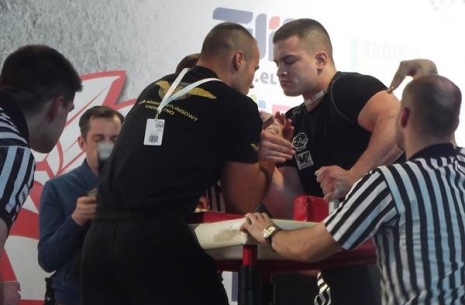
Success is an endless road and you need to train regularly and wisely, with professional help and advice – Łukasz Obłuski. ()
What technique do you use?
I fight with hook.
Why hook?
I’ve been using hook ever since I started armwrestling, and my forearm is quite short, so this technique is the best for me. Although - with time - I’ve started to fight over the top a lot, because hook is much more injury-risky. If I get a tall opponent, with a long forearm – I try to go over the top or get a break-up. When I was just starting to train armwrestling, I was working mainly on my bicep and wrist curls; they were very helpful with the hook. I did pronations very seldom. I thought that since I fought with hook, then over the top exercises would not be useful for me. Back then I used to watch my every fight a couple dozen times , to see where I went wrong.
There was usually one main reason – lack of strong pronation. Because I fought with hook and didn’t train over the top – my pronation was weak and my wrist went down easily. Always remember – no matter what technique you use, always train for hook and over the top equally!
Why is that?
Because if you have a weakness, it will lead to failure. I had huge gaps in my repertoire because of that, but I’m still learning, perfecting my technique and mending the gaps.
What are your three favorite exercises?
One of my favorites is prayer bench forearm curls – gives me power in biceps and in angles; which are very important in every technique. Another great exercise is pulldowns on regulated pulley, using straps. This has got to be my favorite, because it targets fingers, wrist, biceps, chest and back. My third favorite exercise is wrist curls with dumbbells with fat grip, rested perpendicularly on my knee. This one hits forearm and wrist in a major way.
What are your ways to regenerate?
Regeneration has a very wide meaning. Many beginners don’t even bother with it. I did the same, I just thought – why bother? I trained harder and more, thinking that this way I’ll get in better shape much quicker, but the opposite happened. I got more and more tired, less motivated to train and my progress was stunted. I started thinking why was that? The answer was simple – overtraining. This happens most often not because of hard training, but lack of proper regeneration and rest. Diet also plays a major role here. A poor diet goes toward overtraining as much as lack of vitamins.
This is a good moment to speak about injuries …
The most serious one was the shoulder surgery.
I had the front bit of my shoulder bone broken off, responsible for stabilizing my shoulder joint. I’ve gone through long and painful rehabilitation after that, had to do a lot of individual exercises in order to get it mobile and flexible again. I had treatments, too – lasers, magnetic field, cryotherapy, terapuls, elastic bands work. It was actually kind of funny – after the removal of the stabilizer I had to wear on my shoulder for 6 weeks, my muscles were so weak that I couldn’t lift a 2 kg dumbbell with my bicep; and when I lay on my back, I couldn’t lift my arm from the ground. Fortunately I managed to get better and stronger than I ever was.
I also have some chronic pains in my fastenings, elbow tendons, and wrists. Nothing can really help with that, besides a break from training.
What about supplements?
I use them often, they help cure inflammations and get stronger after trainings. They often contain substances like glucosamine, chondroitine, msm, collagen proteins, hyaluronic acid and vitamins. Results can be observed after long-time use. It’s best to take these as a prophylactic measure rather than a cure.
How do you regenerate before and after a competition?
First of all, I take 5-7 days off training before a competition. I prepare very hard for competitions and my arms are very sore and tired, they need a few days off to regenerate. If I can allow myself to eat without cutting weight, I load up on carbs and fats, to feel better and have more energy. If I feel any pains and aches, I go to massages, which often leave me even more sore. But that passes quickly, and the effects are beneficent. As for after-tournament regeneration – that depends if I het ay injuries. If not, then I just rest for a week or two, and then slowly get back to training. If I do, then I rest for 3 – 4 weeks, go to therapies like lasers and cryotherapy and massages. Remember, that for a therapy to really work, you need to go full cycle, at least 10 days in a row, ad when you do get back to training – start with small weights. I usually start with expanders.
What do you have to say to beginners in armwrestling?
First of all – remember to regenerate and don’t overtrain, it will stunt your growth. People who do that, often stop training. The road to success is endless, you need to use your head, get professional help and advice. Beginners make a lot of mistakes in training and in diet. It’s worth it to find someone who has a lot of knowledge in the fields of training and diet, to help you prepare.
Iza Małkowska



Archive >>>
Last week's most popular articles
Matt Germany: Unexpected Power
Take a holiday photo and win a practice grip!
Tomasz Żocholl – from strongman to armwrestler